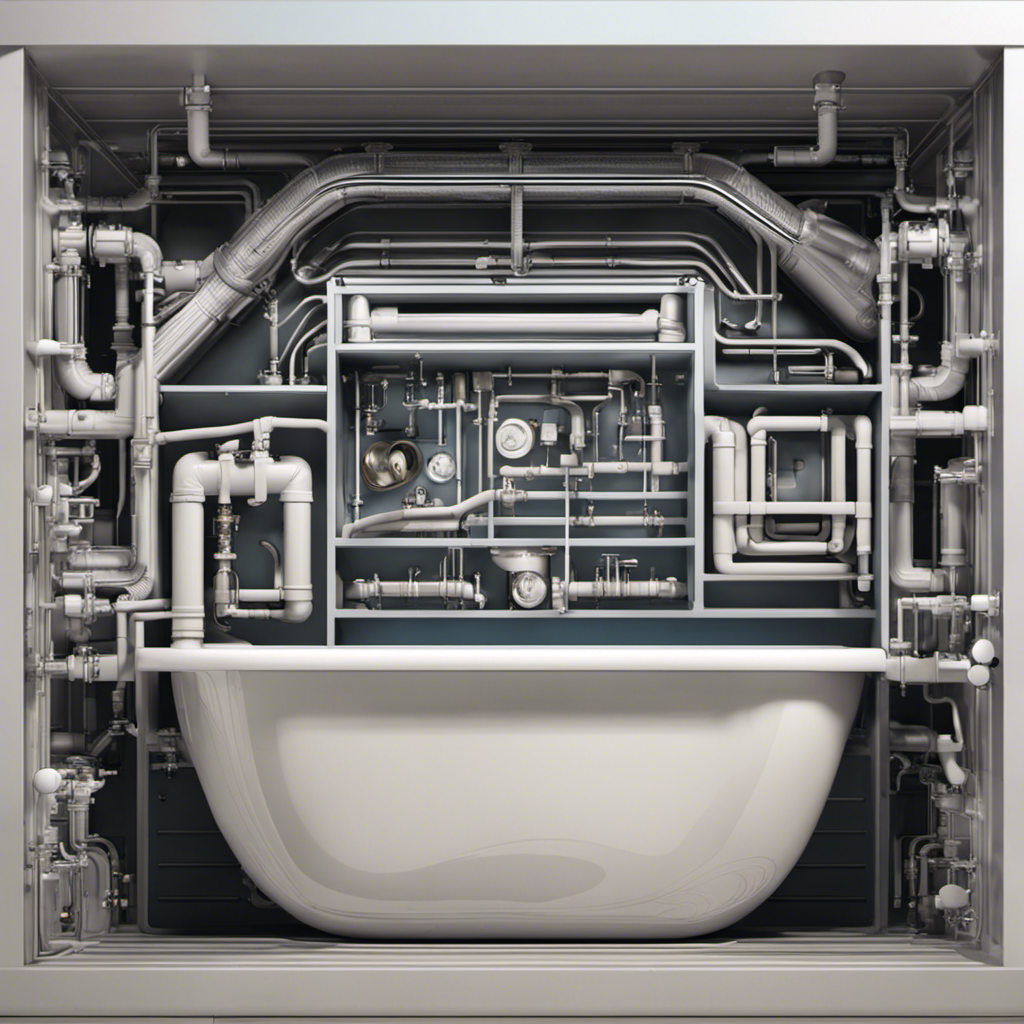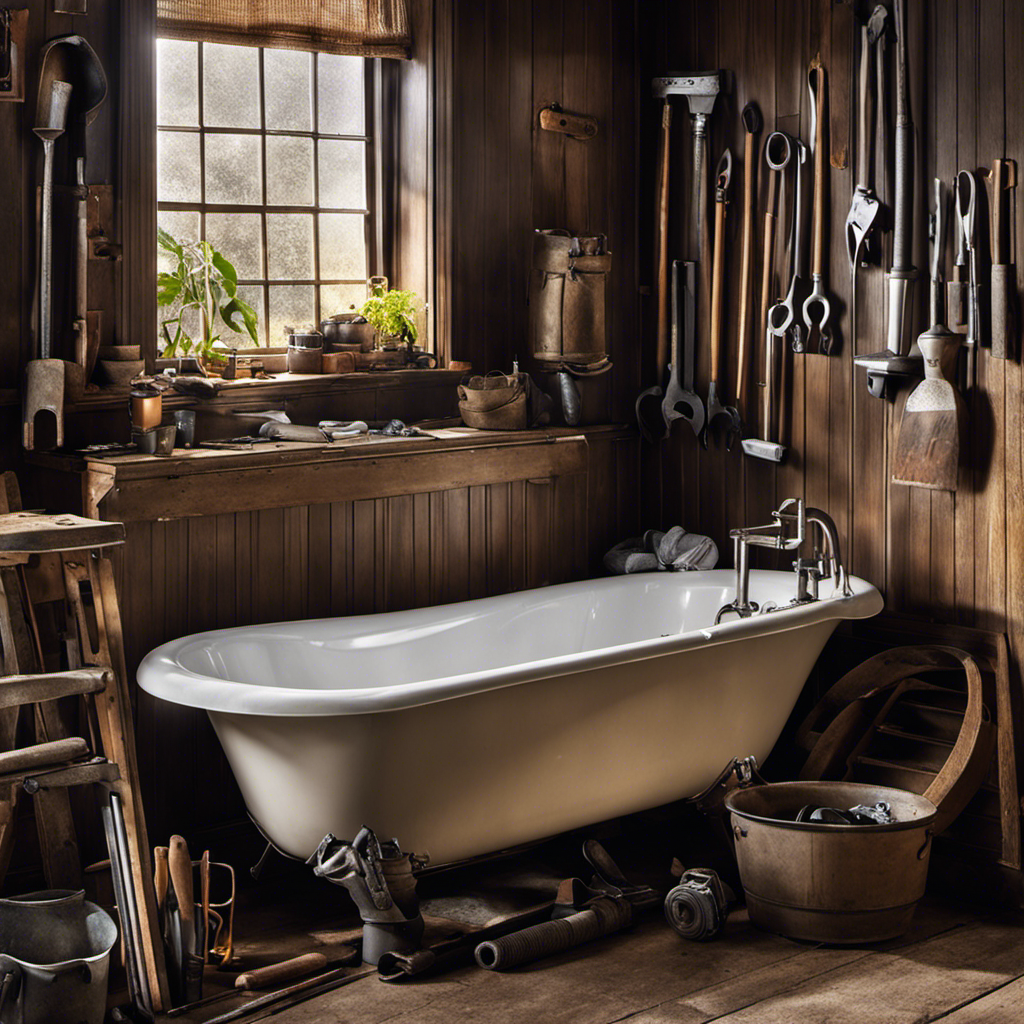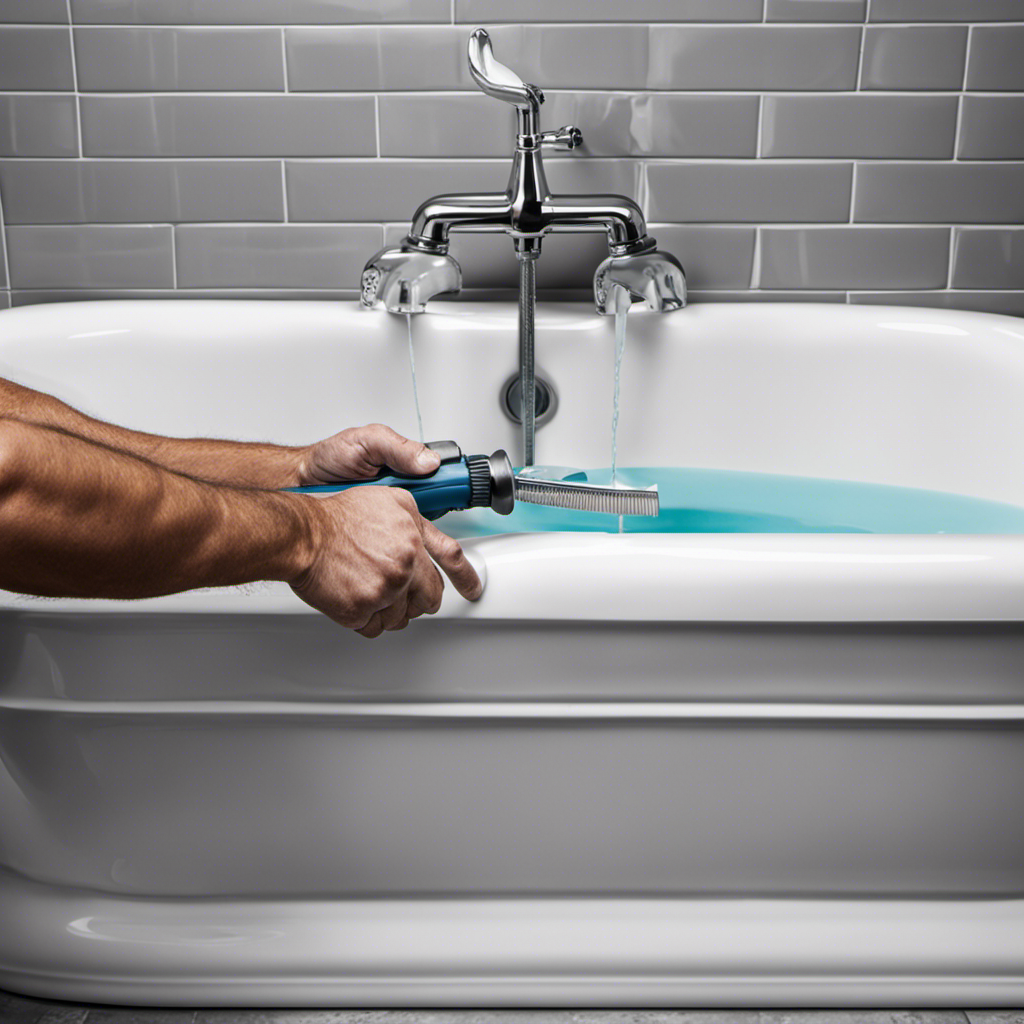As I lay back in my bathtub, I marvel at how effortlessly the water disappears when I pull the drain plug.
Have you ever wondered how this magical vanishing act occurs? In this article, we will explore the inner workings of a bathtub drain, uncovering the role of gravity and the function of the drain stopper.
We will also delve into common issues and troubleshooting tips, as well as maintenance and cleaning tips to keep your bathtub drain working efficiently.
So, let’s dive in and unravel the mystery of how a bathtub drain works.
Key Takeaways
- Gravity is the primary force that pulls water downwards, causing it to drain.
- Different types of drain stoppers, such as lift-and-turn, push-pull, and pop-up stoppers, control the flow of water and prevent it from flowing out of the tub.
- Proper installation of drain stoppers is crucial to ensure their correct functioning and avoid leaks and water damage.
- Clogging is a common issue with bathtub drains, and troubleshooting solutions include using a plunger or drain snake, avoiding putting hair and debris down the drain, and using drain strainers to catch materials before they cause a clog.
Anatomy of a Bathtub Drain
The anatomy of a bathtub drain includes a stopper that can be lifted or pushed down to control the flow of water. When it comes to bathtub drain installation, there are different types of stoppers to choose from.
One common type is the lift-and-turn stopper. This stopper has a knob on top that can be twisted to either lift or lower the stopper.
Another type is the push-pull stopper, which can be pushed down or pulled up to open or close the drain.
There are also pop-up stoppers that are operated by a lever on the side of the tub. These stoppers are convenient as they can easily be lifted to allow water to flow or pushed down to stop the water from draining.
Overall, understanding the different types of bathtub drain stoppers is essential for proper installation and efficient water flow control.
The Role of Gravity in Draining the Bathtub
Gravity plays a significant role in how a bathtub drains. When the stopper is removed, water flows from the bathtub through the drain due to the force of gravity pulling it downwards. The effects of water pressure on the bathtub drain are also important to consider. As water fills the tub, the pressure increases, creating a push that aids in the draining process. To illustrate this, let’s examine the table below:
| Water Level | Water Pressure | Draining Efficiency |
|---|---|---|
| Low | Low | Slow |
| Medium | Medium | Moderate |
| High | High | Fast |
While gravity is the primary driving force, there are alternative methods to drain a bathtub. Some examples include using a pump or siphoning the water out. However, these methods may not be as efficient or as convenient as relying on gravity.
Understanding the Function of the Drain Stopper
When the drain stopper is in place, it prevents water from flowing out of the tub. The drain stopper is an essential component of the bathtub drain system, as it allows you to control the flow of water and keep the tub filled.
There are different types of drain stoppers available, including pop-up stoppers, toe-tap stoppers, and lift-and-turn stoppers. Proper installation of the drain stopper is crucial to ensure that it functions correctly and effectively. It is important to follow the manufacturer’s instructions and make sure that all the components are securely in place. A poorly installed drain stopper can lead to leaks and water damage.
Now that we understand the function of the drain stopper, let’s explore common issues and troubleshooting tips for bathtub drains.
Common Issues and Troubleshooting Tips for Bathtub Drains
Now that we’ve covered the function of the drain stopper, let’s dive into common issues and troubleshooting tips for bathtub drains.
One of the most common problems with bathtub drains is a clog. If you notice that the water is draining slowly or not at all, there are a few troubleshooting solutions you can try.
First, you can use a plunger to create suction and dislodge the clog. Another option is to use a drain snake to physically remove the obstruction. If these methods don’t work, you may need to use a chemical drain cleaner or call a professional plumber.
To prevent clogged drains, it’s important to avoid putting hair, soap scum, or other debris down the drain. Using a drain strainer can help catch these materials before they cause a clog.
Maintenance and Cleaning Tips to Keep Your Bathtub Drain Working Efficiently
To keep your bathtub drain working efficiently, it’s important to regularly clean and maintain it. Here are four preventive measures for bathtub drain maintenance:
-
Use a drain stopper: Placing a drain stopper in your bathtub helps prevent hair, soap scum, and other debris from entering the drain and causing clogs.
-
Clean the drain regularly: Remove any visible debris from the drain using a pair of tweezers or a drain cleaning tool. This will help prevent clogs and keep the drain flowing smoothly.
-
Flush the drain with hot water: Once a week, pour a pot of boiling water down the drain to help dissolve any buildup and keep the pipes clear.
-
Choose the right cleaning products: Avoid using harsh chemicals that can damage your pipes. Instead, opt for natural or enzyme-based drain cleaners that are safe for your bathtub drain.
Frequently Asked Questions
How Can I Prevent My Bathtub Drain From Getting Clogged?
To prevent my bathtub drain from getting clogged, I use preventive measures like using a drain cover and regularly cleaning the drain. I also opt for natural remedies like using baking soda and vinegar to dissolve any buildup.
Are There Any Environmentally-Friendly Ways to Clean My Bathtub Drain?
Sure, there are plenty of environmentally-friendly ways to clean your bathtub drain. You can try using natural drain cleaners like vinegar and baking soda, or DIY drain cleaning methods like using a plunger.
Can I Use Chemical Drain Cleaners to Unclog My Bathtub Drain?
I wouldn’t recommend using chemical drain cleaners to unclog my bathtub drain. There are alternative methods that are safer and more environmentally-friendly. Chemical drain cleaners can pose potential dangers to both your health and the plumbing system.
What Should I Do if My Bathtub Drain Is Leaking?
If my bathtub drain is leaking, I would first assess the severity and try simple repairs like tightening connections. If the issue persists, hiring a professional plumber would ensure a proper fix.
Is It Possible to Install a New Bathtub Drain Myself?
Yes, it is possible to install a new bathtub drain myself. By following the proper steps and using the right tools, I can successfully complete the bathtub drain replacement.
Conclusion
In conclusion, understanding how a bathtub drain works is crucial for maintaining a functional and efficient bathroom. The intricate anatomy of the drain, the role of gravity in its operation, and the function of the drain stopper all contribute to the smooth flow of water down the drain.
However, common issues can arise, causing clogs and disruptions. By following maintenance and cleaning tips, you can ensure that your bathtub drain continues to work effortlessly, providing you with a relaxing and enjoyable bathing experience.










